|
|
|
Sort Order |
|
|
|
Items / Page
|
|
|
|
|
|
|
| Srl | Item |
| 1 |
ID:
124524
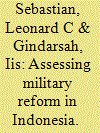

|
|
|
|
|
| Publication |
2013.
|
| Summary/Abstract |
This article seeks to assess the magnitude of military reform in Indonesia and its impact in establishing greater levels of professionalism within the armed forces. To this end, the authors will offer some reflections on the studies of civil-military relations and military transformation for inculcating a higher degree of military professionalism; analyse to what extent the process of military reform in Indonesia has reshaped the institutional role of the armed forces; and discern three major strategic gaps in Indonesia's military reform, namely the "legal loopholes and regulation vacuum," the "shortcomings of democratic civilian control," and the "defence-economic gap." This article asserts that military professionalism will grow more substantially depending on the ability of civilian elites to exercise effective control over the military and the capacity of the government to transform the military establishment keeping pace with strategic challenges and operational requirements.
|
|
|
|
|
|
|
|
|
|
|
|
|
|
|
|
| 2 |
ID:
106482


|
|
|
| 3 |
ID:
076152
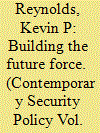

|
|
|
|
|
| Publication |
2006.
|
| Summary/Abstract |
The United States military is in the midst of a major transformation effort, largely conceived around weapons systems procurement. This process of transformation through acquisition will not produce fully operational capabilities for another 15-20 years. But will the capability sets that these weapons represent enable, or will they constrain, the policy options of future national decision-makers? Although national security policy should drive the development of future military capabilities, that is seldom the case, as these problems show. The problem arises largely from three challenges to transformation: the difference in planning horizons between national security and weapons systems or policy lag; problems with the role of the armed forces in weapons systems decision-making; and the Department of Defense's fixation on the narrow theoretical constructs of Network Centric Warfare. These problems are illustrated here by the US Army's dominant contemporary procurement project, the Future Combat System. Overcoming these challenges will require bureaucratic reform throughout the government's national security community, including the National Security Council, Department of Defense and the Congressional Armed Services committees.
|
|
|
|
|
|
|
|
|
|
|
|
|
|
|
|
| 4 |
ID:
086248
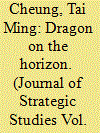

|
|
|
|
|
| Publication |
2009.
|
| Summary/Abstract |
China's grand ambition is to become a world-class military industrial power by 2020, but can it succeed? A concerted restructuring of the defense industry is taking place to tackle deep-seated obstacles constraining its ability to absorb, create and diffuse technological innovation. This includes promoting competition and creativity by reducing the reach of the state and encouraging enterprises to play a leading role, developing a robust regulatory and standards regime to provide benchmarks and rules, and forging integration between the civilian and military portions of the economy through spin-ons.
|
|
|
|
|
|
|
|
|
|
|
|
|
|
|
|
| 5 |
ID:
083078


|
|
|
|
|
| Publication |
2008.
|
| Summary/Abstract |
The British military have embarked on a comprehensive process of transformation towards a network-enabled, effects-orientated, and expeditionary force posture. This has involved developing brand new military doctrine, organizational concepts, and technology. The US military are also transforming, and American military ideas about network-centric and effects-based warfare have influenced the British military. But the British have not simply aped their US ally. Rather, British military transformation has followed a different path. Hence, this article proposes a dynamic model of military innovation involving two international drivers: new operational challenges and military emulation; and three national shapers: resource constraints, domestic politics and military culture. This model is then applied to a detailed empirical analysis of the process and progress of British military transformation
|
|
|
|
|
|
|
|
|
|
|
|
|
|
|
|
| 6 |
ID:
108729
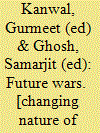

|
|
|
|
|
| Publication |
New Delhi, Centre for Land Warfare Studies, 2011.
|
| Description |
xxiv, 231p.
|
| Standard Number |
9788191014259
|
|
|
|
|
|
|
|
|
|
|
|
Copies: C:1/I:0,R:0,Q:0
Circulation
| Accession# | Call# | Current Location | Status | Policy | Location |
| 056381 | 303.690954/KAN 056381 | Main | On Shelf | General | |
|
|
|
|
| 7 |
ID:
061251


|
|
|
| 8 |
ID:
148252
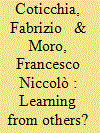

|
|
|
|
|
| Summary/Abstract |
How does military change take place in states that are not able to develop autonomous solutions? How does transformation occur when limited resources are available? What are the “sources of military change” for armed forces that do not possess the (cognitive and material) resources that are essential for autonomous development? In articulating an answer to these questions, this article draws from the theoretical debate on interorganizational learning and looks at the mechanisms that drive “learning from others.” We argue that adaptation and organizational learning often had to look for, and then try and adapt, off-the-shelf solutions that required relatively more limited resources. Empirically, the article focuses on the Italian Armed Forces, which have rarely attracted scholarly attention, although it emerged from almost total lack of activity in the Cold War to extended deployments in the 2000s.
|
|
|
|
|
|
|
|
|
|
|
|
|
|
|
|
| 9 |
ID:
110079
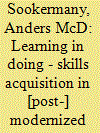

|
|
|
|
|
| Publication |
2011.
|
| Summary/Abstract |
One of the strategic aims of the modernisation of NATO is to develop military forces that can be deployed to conflict areas where and when the need arises, and that have capabilities that are as well-adapted to the situation as possible. What consequences will this have for how we think about skills acquisition in the professional military communities of practice of the future? The intention of this article is to seek understanding concerning precisely this: how situation-dependent skills can be acquired. In examining this issue, I draw attention to new learning-related concepts and insights that may provide solutions to the complex situational challenges that [post]modern military operations present to soldiers and their communities of practice in relation to skill utilisation and skills acquisition. I therefore seek to link the ongoing military transformation with the growing debate about practice-centred learning generally, and apprenticeship-like forms of learning, such as situated learning, in particular.
|
|
|
|
|
|
|
|
|
|
|
|
|
|
|
|
| 10 |
ID:
137553
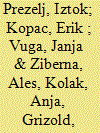

|
|
|
|
|
| Summary/Abstract |
The military transformation process typically focuses on the structural, operational, technical, personnel, training, and similar dimensions. Yet conceptual and practical approaches to such transformation have largely neglected the importance of the perceptional and subjective aspects that have frequently negatively affected this process. This article fills this gap by developing the Input-Process-Output Transformation Model and testing it on a sample of 55 military transformation experts from 23 NATO and PfP countries. The results highlight what are perceived to be the most important variables affecting the transformation input, process, and output that need to be incorporated in future integrated transformation strategies. It also turns out that transformation strategies need to increase the involvement of civil society, improve public support, the level of internal understanding of transformation goals, and the level of experimentation.
|
|
|
|
|
|
|
|
|
|
|
|
|
|
|
|
| 11 |
ID:
104763


|
|
|
|
|
| Publication |
2011.
|
| Summary/Abstract |
Austria, Finland, Sweden and Switzerland share a commitment to military non-alliance as a common Cold War legacy. But divergent threat perceptions and interpretations of neutrality have shaped their subsequent military transformation, leading to co-operation inside the EU and with NATO for most and a focus on homeland defence or domestic tasks for some.
|
|
|
|
|
|
|
|
|
|
|
|
|
|
|
|
| 12 |
ID:
142361


|
|
|
| 13 |
ID:
138742
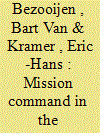

|
|
|
|
|
| Summary/Abstract |
Theory on the use of information technology in military operations assumes that bringing together units in an information network helps units to work together. Decentralized command systems such as mission command have been proposed for these networks, so that units can adapt to changes in their turbulent working environments. Others have proposed centralized command systems that permit higher organizational levels to closely direct military operations. This article uses Perrow’s (1984, 1999) Normal Accidents Theory to propose that increasing interdependencies between units in information networks places incompatible demands on the design of networked military operations. It is concluded that networked military operations require decentralized command approaches, but only under the condition that interdependencies between modules of networked units are weak rather than tight. This precondition is essential for retaining control over networked military operations.
|
|
|
|
|
|
|
|
|
|
|
|
|
|
|
|
| 14 |
ID:
096852
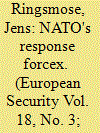

|
|
|
|
|
| Publication |
2009.
|
| Summary/Abstract |
At the Riga Summit in November 2006, NATO (North Atlantic Treaty Organization) declared the NATO Response Force (NRF) a fully operational capability. Yet only 8 months later - and behind closed doors - the Alliance's military authorities rescinded the declaration as it became increasingly clear that member states were unwilling to make the necessary commitments to the force. To this day, the force has been a qualified failure: while many allies have benefited from participating in the NRF, lack of concrete troop commitments and disagreement as to the force's operational role have largely eroded its credibility. This could change with the allies' recent adoption of a revised NRF-construct. However, as NATO is still in a state of strategic confusion, the NRF is likely to continue to be different things to different nations.
|
|
|
|
|
|
|
|
|
|
|
|
|
|
|
|
| 15 |
ID:
099704


|
|
|
|
|
| Publication |
2010.
|
| Summary/Abstract |
The North Atlantic Treaty Organization (NATO) has since the turn of the new century experienced a double transformation gap: between global and regionally oriented allies and between allies emulating new military practices defined by the United States and allies resisting radical change. This article takes stock of these gaps in light of a decade's worth of collective and national adjustments and in light of counter-insurgency lessons provided by Afghanistan. It argues first of all that the latter transatlantic gap is receding in importance because the United States has adjusted its transformation approach and because some European allies have significantly invested in technological, doctrinal, and organizational reform. The other transformation gap is deepening, however, pitching battle-hardened and expeditionary allies against allies focused on regional tasks of stabilization and deterrence. There is a definite potential for broad transformation, our survey of officers' opinion shows, but NATO's official approach to transformation, being broad and vague, provides neither political nor military guidance. If NATO is to move forward and bridge the gap, it must clarify the lessons of Afghanistan and embed them in its new Strategic Concept.
|
|
|
|
|
|
|
|
|
|
|
|
|
|
|
|
| 16 |
ID:
130034
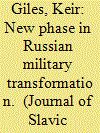

|
|
|
|
|
| Publication |
2014.
|
| Summary/Abstract |
Fundamental reform of Russia's military has passed through a number of distinct phases since its inception in late 2008. This paper describes the phase of consolidation and stability begun in early 2011. Based on research to June 2012, and pre-dating the replacement of Anatoliy Serdyukov as Russian Defence Minister, the paper shows how early planning and forecasting deficiencies were addressed from 2011 onward, with continuing support at the highest level for the overall aims of military reform. Ongoing problems such as procurement and manpower are discussed as serious challenges to Russian military aspirations, and further specific challenges affecting each individual arm of service are described. In conclusion, Russia's new military capabilities, and the state's rationale for introducing them, are considered.
|
|
|
|
|
|
|
|
|
|
|
|
|
|
|
|
| 17 |
ID:
156334


|
|
|
|
|
| Summary/Abstract |
The term hybrid warfare was first coined by US military scholars and later widely adopted in the West to refer to Russian military operations in the Ukrainian and Syrian crises. In Russia, it is calledGerasimovism. Russia adapted the idea of hybrid warfare for its military operations in Ukraine and Syria into a Russian-Style hybrid warfare that has seen successful results so far. This model is likely to impact future military developments.
|
|
|
|
|
|
|
|
|
|
|
|
|
|
|
|
| 18 |
ID:
143609


|
|
|
|
|
| Summary/Abstract |
Military transformation is a complex, slow, asymmetric, changeable, political, and not necessarily completely rational process that clearly needs an effective monitoring mechanism. This paper fills a gap in current literature by creating and testing a model for multi-dimensional and multi-level quantitative monitoring of military transformation applicable in any country. The model is based on 10 transformation indicators that reflect changes in organizational structure, personnel structure, weapon systems, and defense spending. Its application on a sample of seven countries (USA, United Kingdom, France, Netherlands, Poland, Russia, and China) in the period from 1992 to 2010 unexpectedly shows that the USA – a protagonist in the transformation process among allies as well as globally – has carried out the smallest relative change. The non-directed transformation index indicates that Russia carried out 51.8% more change (or 34.1 index units), and the directed index indicates that Poland carried out 157.2% (or 40.8 index units) more change than the USA.
|
|
|
|
|
|
|
|
|
|
|
|
|
|
|
|
| 19 |
ID:
104624
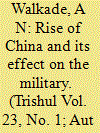

|
|
|
| 20 |
ID:
177762


|
|
|
|
|
| Summary/Abstract |
Between 1989 and 2018, the basic characteristics of the security perception of the Hungarian society remained constant, but significant changes occurred in the realm of security policy. The security perception of the Hungarian society retained its multidimensional character, while non-military dimensions became increasingly predominant. As a consequence of the changing strategic environment and the country's accession to NATO, Hungary became a more active actor in international security policy, albeit with strict limitations on the use of force. The changes in Hungary's foreign policy orientation after the end of the Cold War can be best described as a gradual and consistent shift towards Euro-Atlantic integration, facilitated by both external and internal factors. Furthermore, the Hungarian Defence Forces began their transformation from a Soviet-type mass army into a Western-type of expeditionary model of armed forces, that has been further accelerated by a new large-scale modernisation programme since 2016.
|
|
|
|
|
|
|
|
|
|
|
|
|
|
|
|
|
|
|
|
|